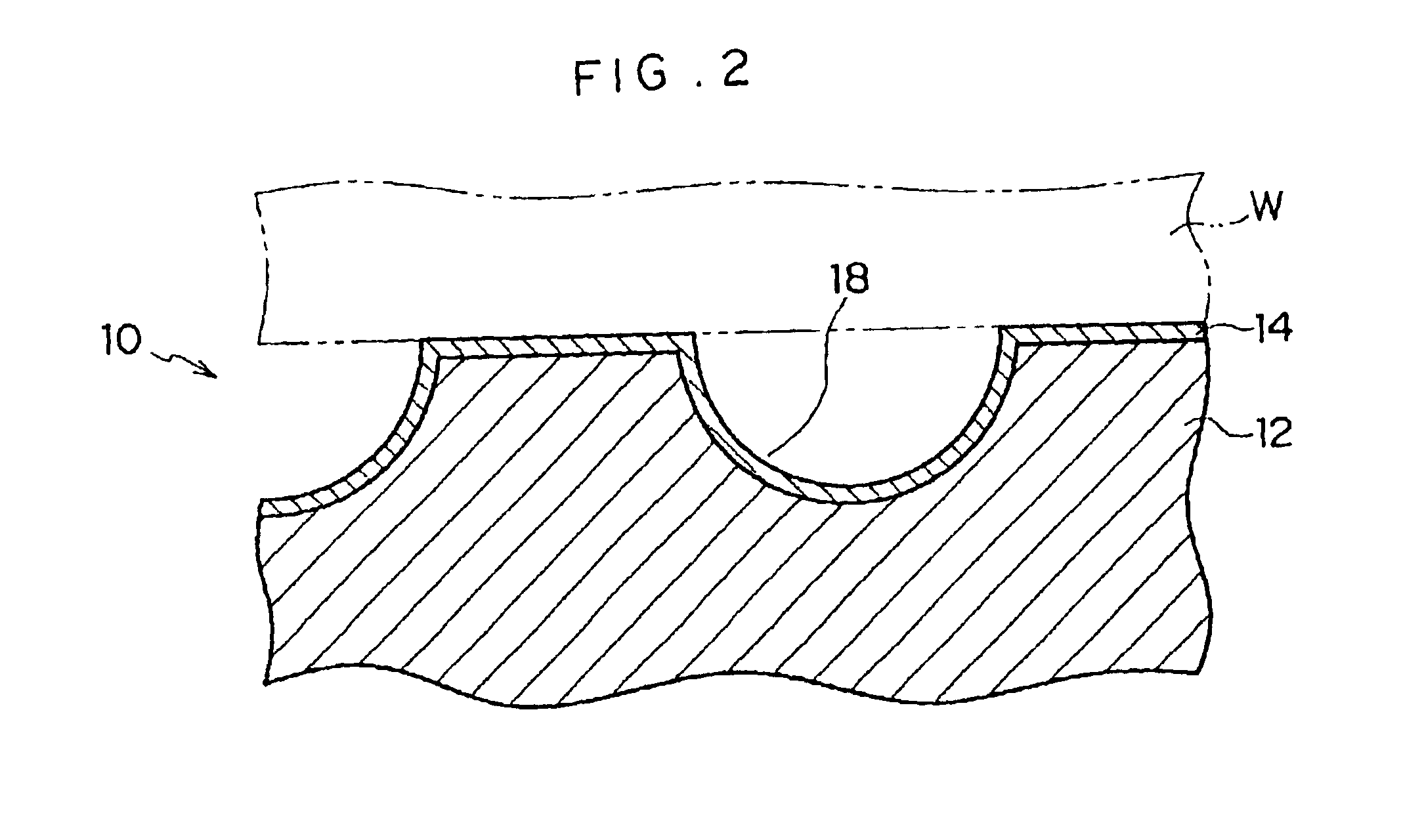Rod for a coating device, and process for producing the same
- Summary
- Abstract
- Description
- Claims
- Application Information
AI Technical Summary
Benefits of technology
Problems solved by technology
Method used
Image
Examples
first embodiment
[First Embodiment]
[0103]As illustrated in FIG. 1, a rod 10 according to the first embodiment is a rod for both of coating a running web W with a coating solution and adjusting the amount of the coating solution.
[0104]The rod 10 is a rod in which an abrasion-resistant coating 14 is formed on the circumferential surface of a columnar base material 12. In many cases, the base material 12 is made of stainless steel. In the circumferential surface of the base material 12, many grooves 18 are made along the circumferential direction (that is, a direction which is perpendicular to the axial direction and is along the running direction of the web W) (see FIG. 2) As a result, the circumferential surface of the rod is made irregular.
[0105]When the friction coefficient between the coating 14 and the web W is represented by μ, the material of the coating 14 is selected in such a manner that the value of the Vickers hardness Hv of the coating 14 satisfies the following formula (1):
Hv>1500×μ2+...
second embodiment
[Second Embodiment]
[0115]The following will describe a rod according to a second embodiment. In the second embodiment, to the same constituent elements as in the first embodiment are attached the same reference numbers. Description thereon is omitted.
[0116]A rod 220 (see FIG. 3) according to the second embodiment is a rod in which an abrasion-resistant coating 222 is formed on a base material 212 in an HCD manner (holocathode manner).
[0117]The surface state of the coating 222 formed in the HCD manner is superior in smoothness to that of any coating formed in any other manner of ion plating. For this reason, the contact area between the coating and the running web W increases so that a maximum shearing stress generated in the coating in the step of coating decreases. Since this makes the abrasion rate of the coating 222 small, the abrasion resistance of the coating 222 can be made better than in the first embodiment.
[0118]As the material of the coating 222, DLC (diamond-like carbon) ...
example 1
[0120]Base materials, made of stainless steel (SUS 304) and having a diameter of 13 mmφ, were used as the base materials 12 to produce rods in which materials of their coatings (coating species) were varied as a parameter. The coatings were formed by ion plating.
[0121]These rods were used as rods for performing both of the coating of the running web W and the adjusting of the amount of a coating solution. As illustrated in FIG. 1, experiments in which the web W running at a running speed of 50 m / minute was coated with the coating solution were made. The rotation direction Q of each of the rods was set such that the rod surface contacting the web W was shifted to the direction opposite to the web running direction P (see FIG. 1) Regarding physical properties of the coating solution, the viscosity thereof was 8 cp and the surface tension thereof was 22 mN / m. The formulation of the coating solution is shown in Table 1.
[0122]
TABLE 1Polyurethane resin of 4,4-diphenylmethane5.0 gdiisocyan...
PUM
| Property | Measurement | Unit |
|---|---|---|
| Temperature | aaaaa | aaaaa |
| Temperature | aaaaa | aaaaa |
| Thickness | aaaaa | aaaaa |
Abstract
Description
Claims
Application Information
 Login to View More
Login to View More - R&D
- Intellectual Property
- Life Sciences
- Materials
- Tech Scout
- Unparalleled Data Quality
- Higher Quality Content
- 60% Fewer Hallucinations
Browse by: Latest US Patents, China's latest patents, Technical Efficacy Thesaurus, Application Domain, Technology Topic, Popular Technical Reports.
© 2025 PatSnap. All rights reserved.Legal|Privacy policy|Modern Slavery Act Transparency Statement|Sitemap|About US| Contact US: help@patsnap.com



